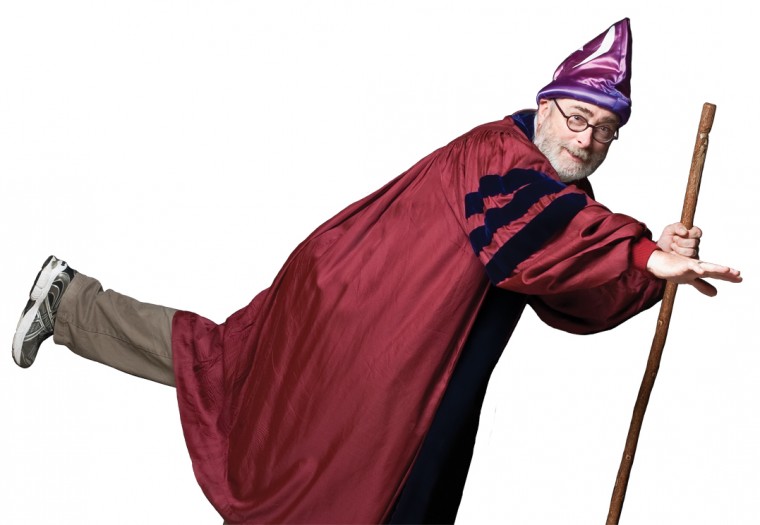Shirley’s new class spellbinds students
Harry Potter fanatics unite. St. Edward’s University now offers a class on the religious symbolism found in the bestselling series, “Harry Potter.”
The course, RELS 2342 Special Topics in Religious Studies: Themes in Harry Potter, is taught by Edward Shirley, professor of Religious Studies.
The idea for the class came to Shirley several years ago when he was teaching a special topics course on the symbolism in C. S. Lewis’ “Chronicles of Narnia.”
“The ‘Harry Potter’ books are just full of religious imagery,” Shirley said. “I’d noticed that the same people that loved ‘Chronicles of Narnia’ seemed to hate ‘Harry Potter,’ and I thought it was interesting, so I decided I wanted to do a class on ‘Harry Potter.'”
While the idea was there, it was quite some time before Shirley was able to realize his dream.
“I kept saying, ‘Well, let’s wait until Rowling finishes the books,'” Shirley said.
Since the class is Shirley’s idea, he created the curriculum for the class as well, with the help of his teaching assistant, junior Lauren May.
The class consists of four houses—Slytherin, Hufflepuff, Gryffindor and Ravenclaw. Each house competes for house points throughout the semester, which students can earn by answering questions.
“This course was literally created over a plate of curly fries at EZ’s,” May said. “We sat there for two hours, tossing ideas back and forth.”
“Lauren came up with about 80,000 ideas for the class,” Shirley said. “Students are organized into houses, and we’ve got the House Cup going. She’s great.”
May said she considered herself to be Shirley’s partner in this class.
“I am the McGonagall to his Dumbledore,” May said.
The class was immediately popular among students, filling up during registration within the first eight minutes, according to Shirley.
“We had people literally begging [Assistant to the Dean] Kim Livingston to let them in the class,” May said.
Senior Nicole Engel, who has taken several courses with Shirley in the past, said she could hardly wait to take the “Harry Potter” class.
“[Shirley] told me my freshman year that he eventually wanted to teach a ‘Harry Potter’ class, and I have been waiting four years for it to finally happen. I’m a huge ‘Harry Potter’ fan. I’m really curious to see what religious symbolism we find in the books. It’s a whole new way of reading them,” said Engel.
The required reading for the course includes five of the seven books in the series: “Harry Potter and the Philosopher’s Stone,” “Harry Potter and the Chamber of Secrets,” “Harry Potter and the Order of the Phoenix,” “Harry Potter and the Half-Blood Prince” and “Harry Potter and the Deathly Hallows.”
Engel, who also took Shirley’s ‘Chronicles of Narnia’ course, said she expects the two classes to be very similar. She said looks forward to examining the novels in detail.
“My favorite part of the class so far is probably the points system they’ve created for the houses,” Engel said. “That and watching a “Potter Puppet Pals” video at the start of class. Professor Shirley always keeps us laughing and the class interesting,” added Engel.
The majority of the time spent in class is devoted to exchanging ideas about the different religious contexts encountered in the books.
“Whether Rowling intended it or not, there are Christ symbols throughout the books,” Shirley said. “Lots of people don’t want to think of Harry as a Christ symbol because, to them, Christ symbol means ‘it is Jesus,’ and that’s just not right. You can have eight different Christ symbols in one story.”
Shirley finds it difficult to understand how some consider the books to be a bad influence.
“People get agitated about the books, calling them ‘anti-family,’ or saying they teach kids there is no right or wrong,” Shirley said. “How is it anti-family? All Harry wants is his parents, and Dumbledore is walking around saying the greatest force in the universe is love,” said Shirley.
“And then you’ve got the Weasleys, who are the epitome of an Irish-Catholic family,” May said.
“Exactly! As far as right and wrong, there’s one line, ‘There is no good or evil, there is only power,’ and who says it? Voldemort! The bad guy,” Shirley said.
Shirley also objected to fabricated claims, such as Rowling being Wiican at some time in her life.
“I hear people saying things that are completely made up like, ‘Oh, well, Rowling used to be a witch,’ and the people that believe these things, and pass them on—well, they’re the real Death Eaters,” joked Shirley.
Part of the problem people have with the books, Shirley believes, is that Rowling has admitted to struggling with her own faith.
“People act like no real Christian has ever struggled with faith,” Shirley said. “I don’t know that she purposely put in all the imagery, but it’s just so much a part of her thinking that it comes out.”
May said she hopes the class will help students look at the literary realm with a more critical eye.
“I really hope students do come away with the idea that these aren’t just kids’ books, and maybe look closely at all books and not just take them at face level,” May said. “It’s like this great cultural study. In 50 years, will these be our great Tolkien novels?”
As far as grading goes, students have three papers to write over the course of the semester and are expected to fully participate in discussions.
“People ask me how I grade, and I just tell them it’s about Transfiguration,” Shirley said. “I mean, if you can make something out of a teacup you’re good to go.”







